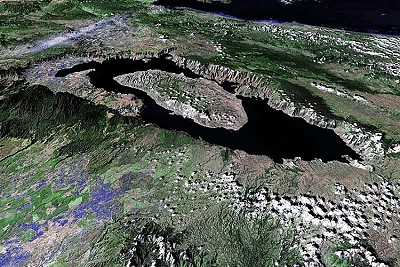 The term "super volcano" is a neologism that first appeared in media reports about the Yellowstone caldera. The USGS then created a definition for supervolcano eruptions. According to this definition, a volcanic eruption is considered "super" if the eruption reaches a VEI 8 and produces at least 1000 cubic kilometers of tephra.
The term "super volcano" is a neologism that first appeared in media reports about the Yellowstone caldera. The USGS then created a definition for supervolcano eruptions. According to this definition, a volcanic eruption is considered "super" if the eruption reaches a VEI 8 and produces at least 1000 cubic kilometers of tephra.
This definition is not shared by all scientists. Some researchers are content with a VEI 7-8 and a tephra output of more than 200 cubic kilometers, so that a strong plinian eruption becomes a super volcano eruption.
Both definitions consider only explosive eruptions and ignore the gigantic effusive eruptions that created flood basalt provinces.
There has never been a super volcanic eruption in historical times and information about volcanic eruptions of this magnitude is based primarily on investigations of the rock strata and morphology of the terrain.
Usually a super volcano eruption leaves a caldera with a diameter of at least 20 kilometers. The tephra deposits often reach thicknesses of more than 100 meters near the volcano.
The indirect effects of supervolcano eruptions are global. The gigantic tephra emissions darken the atmosphere and reduce solar radiation; this results in so-called "global dimming" and a volcanic winter is created. Plant growth is restricted and mass extinction can be caused.
Yellowstone
The most recent example of a super volcano eruption is the eruption of Taupo on New Zealand. It erupted about 26,500 years ago and produced 1170 cubic kilometers of tephra in a VEI 8 eruption.
About 75,000 years ago, the eruption of Toba on Sumatra destroyed almost the entire human race. During this eruption 2,100 cubic kilometers of tephra were produced. The super volcano eruption left a caldera measuring 100 x 30 km. According to genetic researches about 15,000 people are said to have survived the catastrophe.
The most recent eruption of the Yellowstone volcano was about 640,000 years ago and produced 1000 cubic kilometers of tephra. The lava-creek tuffs, which are up to 200 meters thick in Yellowstone, were formed. Yellowstone is always in the headlines because there are signs of recurring activity there.
For comparison, there have been only 5 eruptions in historical times with a VEI of 7. Known catastrophic eruptions such as Vesuvius (VEI 4), Mount St. Helens (VEI 5) and Krakatau (VEI 6) appear almost small against the eruption of a "super volcano".
Flood basalts
The flood basalts were mainly formed in direct connection with large-scale fracture processes of plate tectonics. Apart from the ocean floors, the continental flood basalts represent the largest lava masses ever to emerge at the earth's surface. Within relatively short periods of time, areas of up to one million square kilometers were flooded with basalt lava. The most massive flood basalts were formed in the Upper Jurassic about 165 million years ago when the supercontinent Gondwana broke apart.The amounts of lava produced are enormous and are in the order of several million cubic kilometers of lava. During the Deccan Trap in India about 40 million cubic kilometers were extracted. The Siberian Trapp produced between one million and four million cubic kilometers of basaltic lava.
The most recent example of flood basalts can be found in the US state of Oregon, where the Columbia River basalts were formed 15 million years ago.